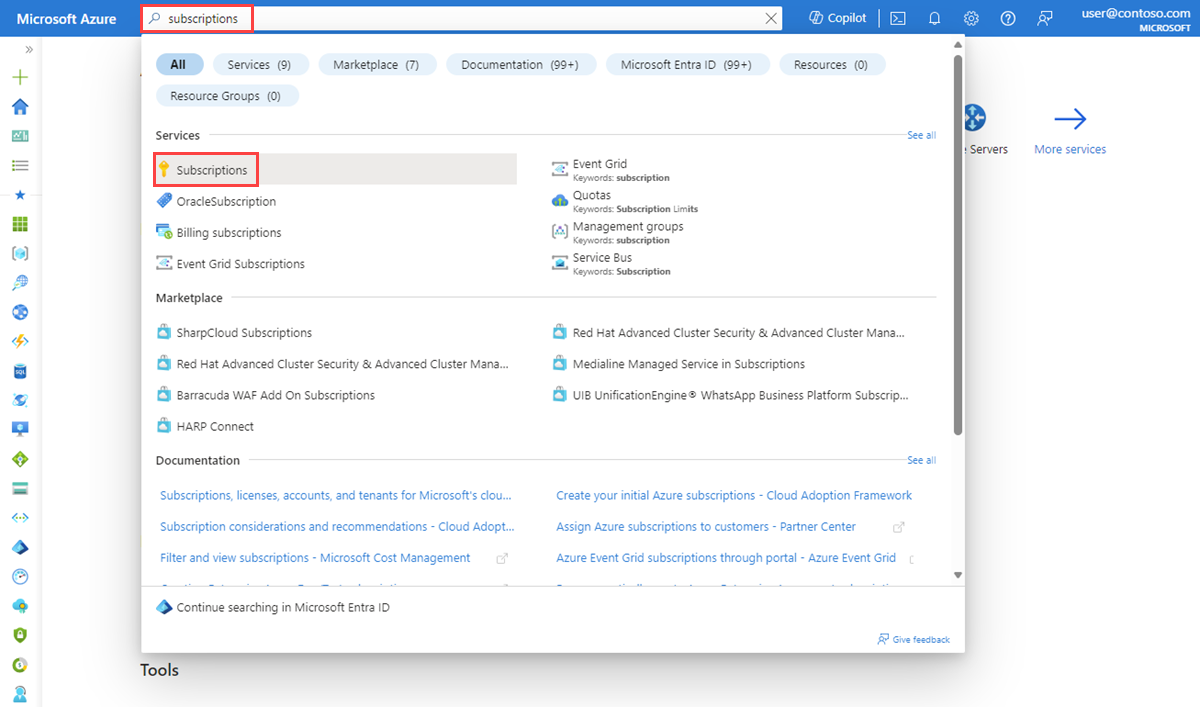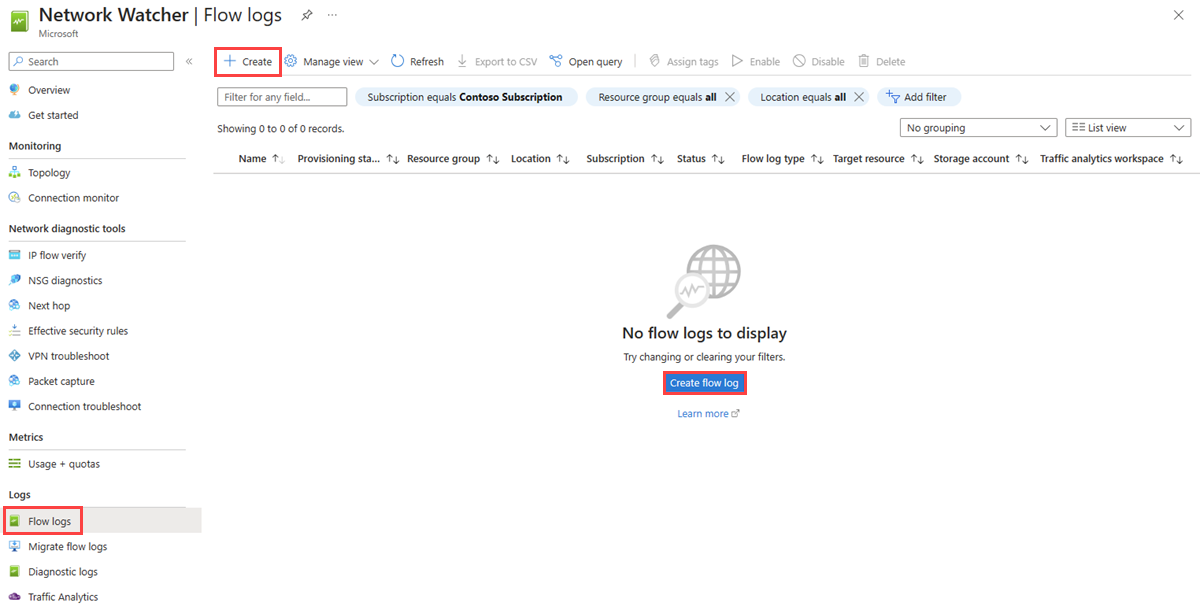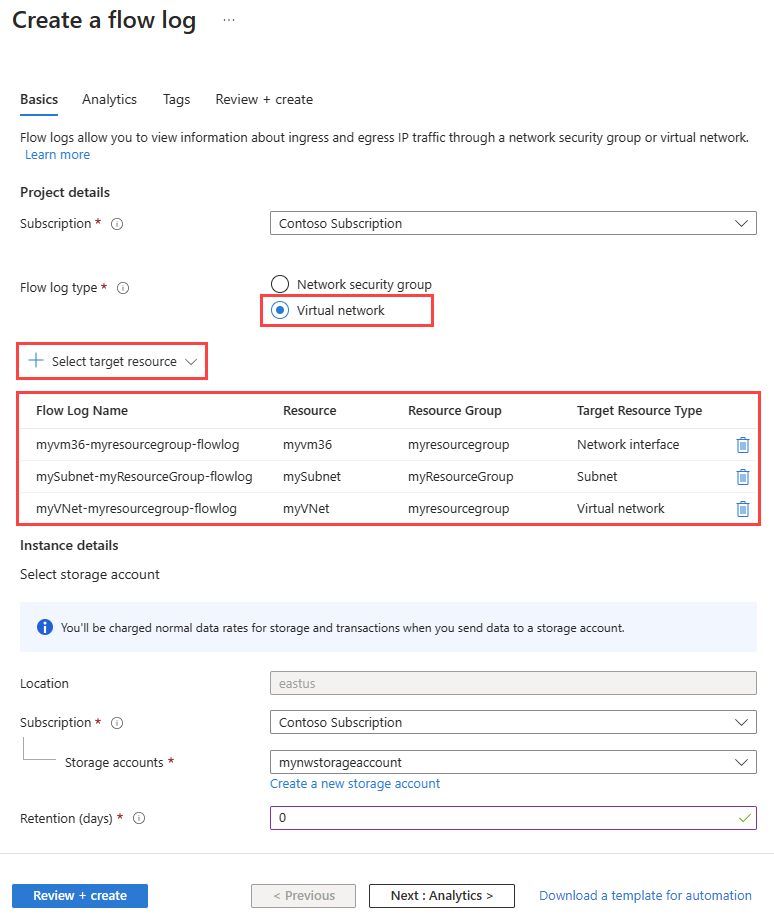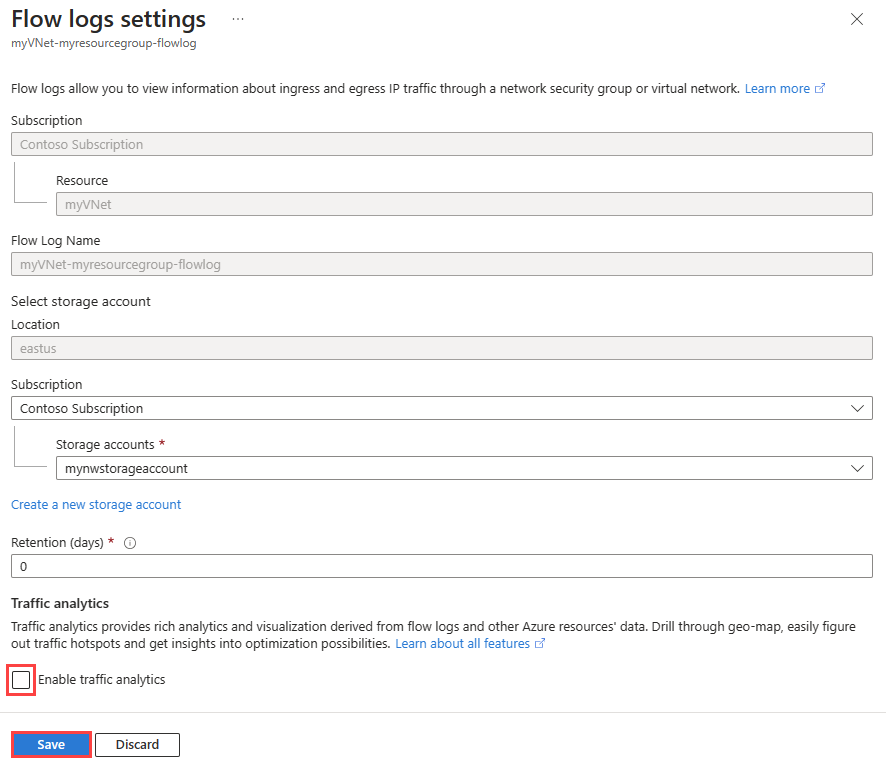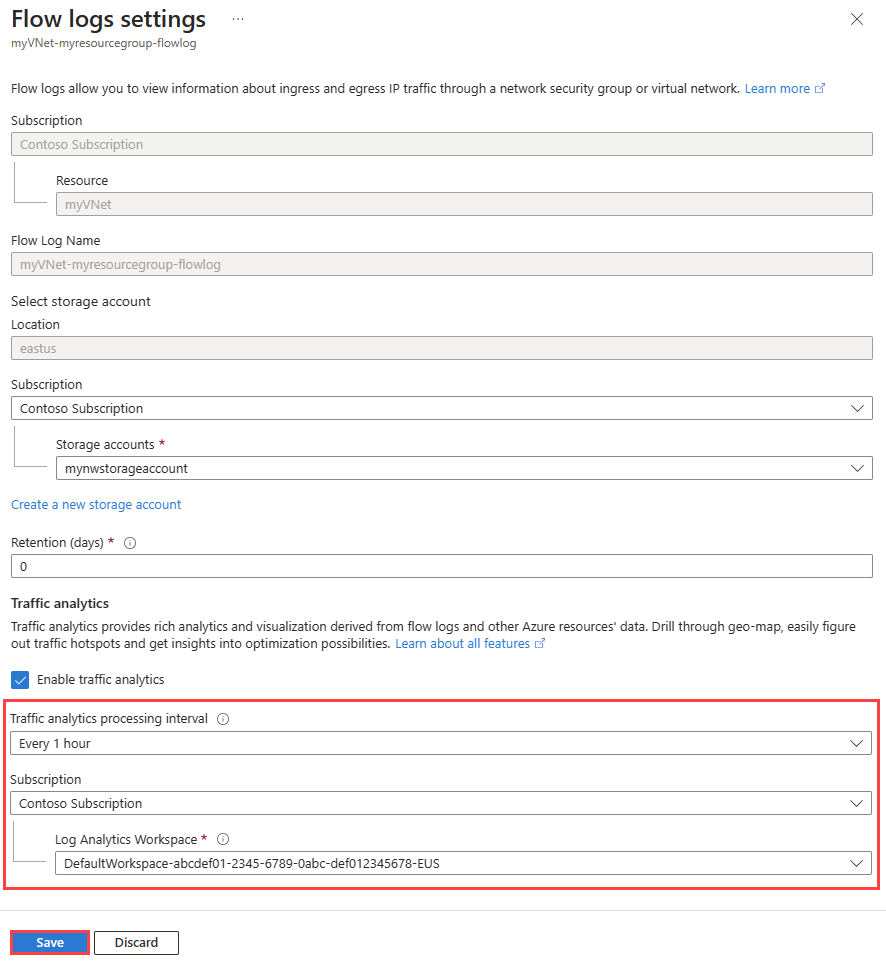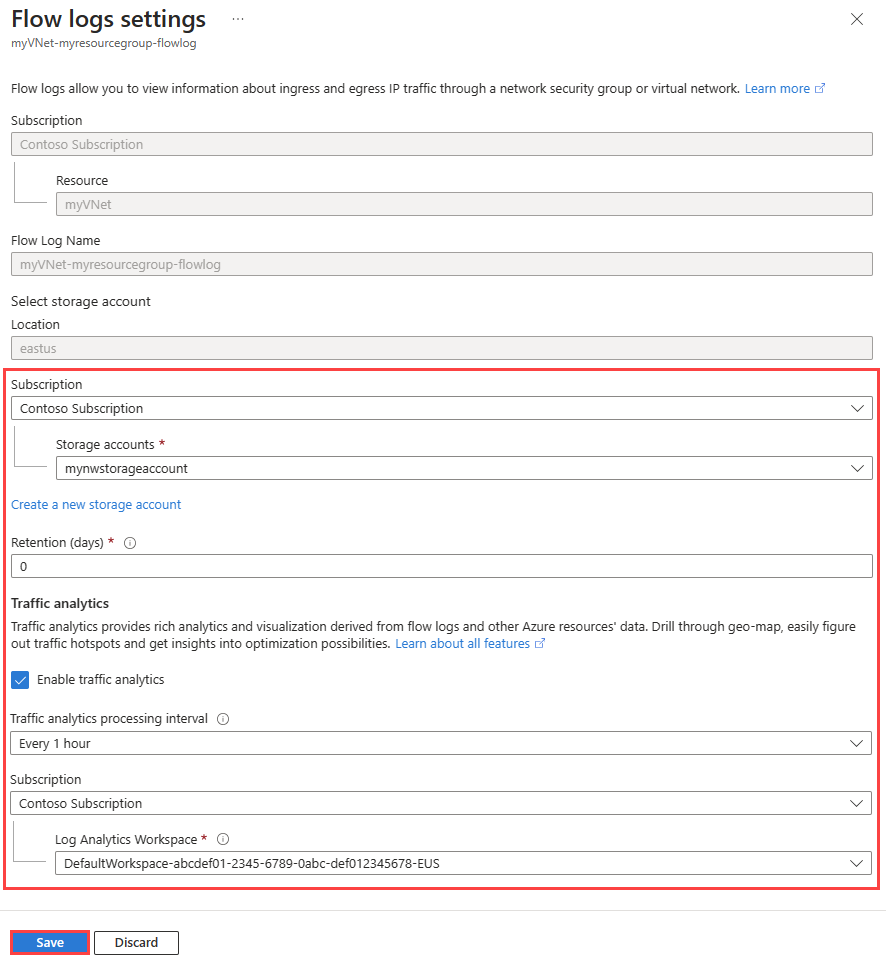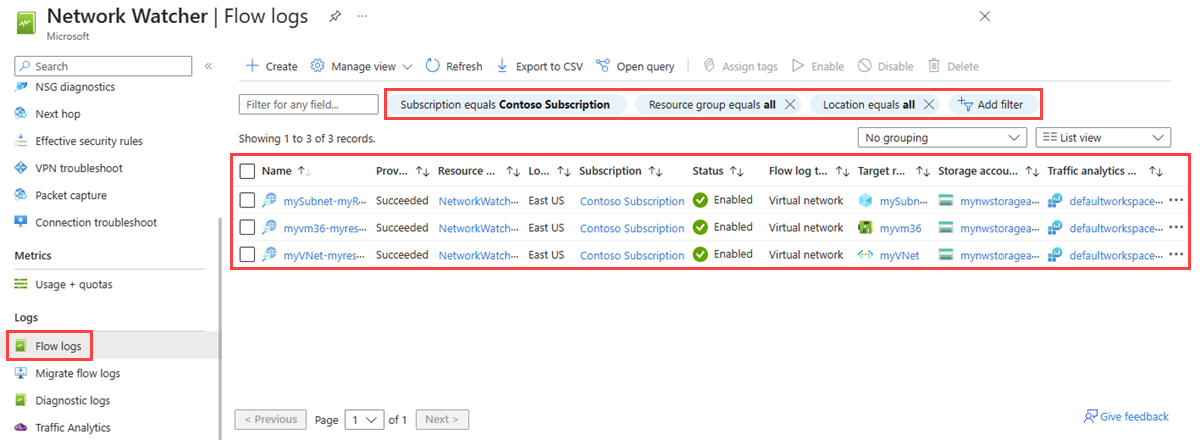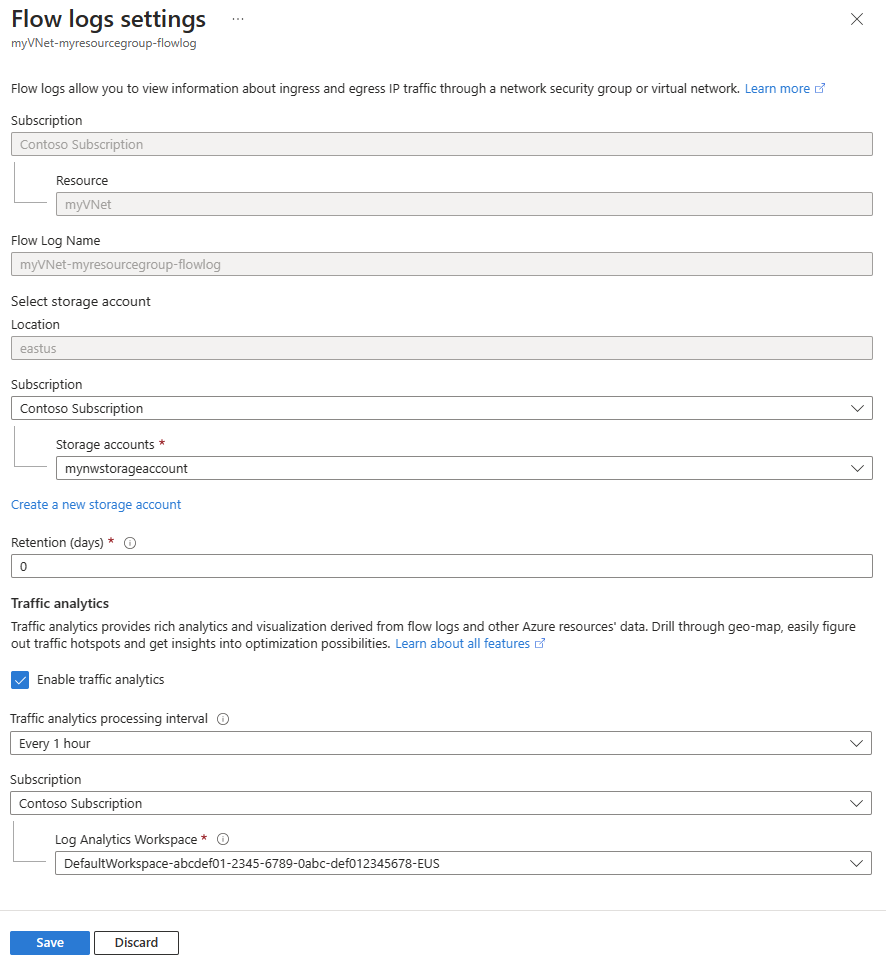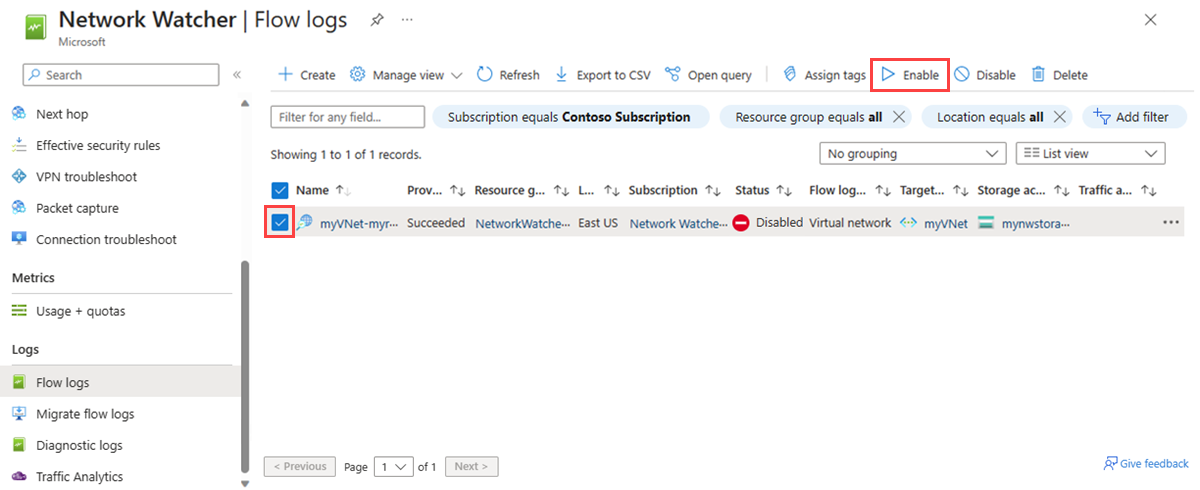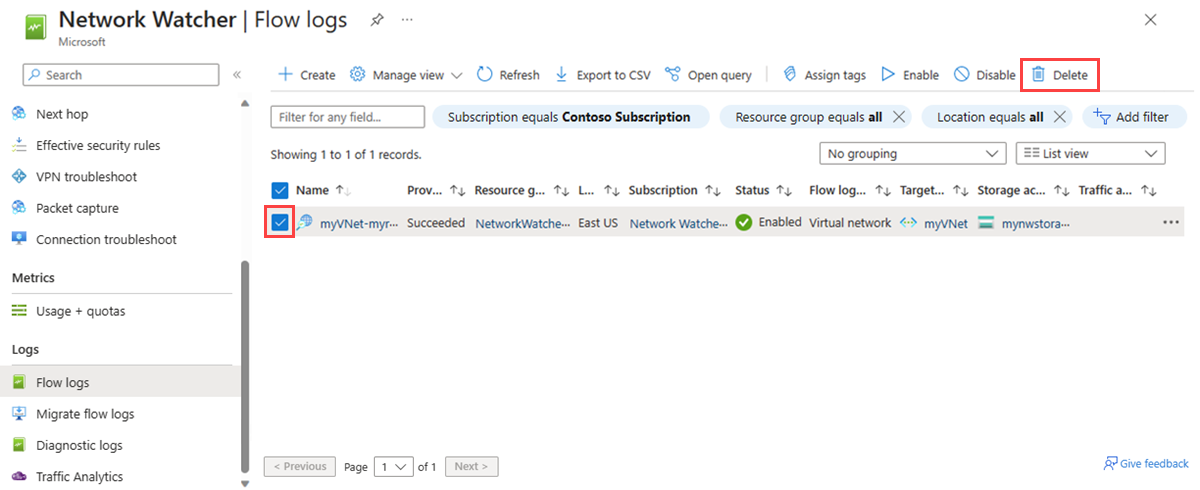Create, change, enable, disable, or delete virtual network flow logs using the Azure portal
Virtual network flow logging is a feature of Azure Network Watcher that allows you to log information about IP traffic flowing through an Azure virtual network. For more information about virtual network flow logging, see Virtual network flow logs overview.
In this article, you learn how to create, change, enable, disable, or delete a virtual network flow log using the Azure portal. You can also learn how to manage a virtual network flow log using PowerShell or Azure CLI.
Prerequisites
An Azure account with an active subscription. Create an account for free.
Insights provider. For more information, see Register Insights provider.
A virtual network. If you need to create a virtual network, see Create a virtual network using the Azure portal.
An Azure storage account. If you need to create a storage account, see Create a storage account using the Azure portal.
Register Insights provider
Microsoft.Insights provider must be registered to successfully log traffic flowing through a virtual network. If you aren't sure if the Microsoft.Insights provider is registered, check its status in the Azure portal by following these steps:
In the search box at the top of the portal, enter subscriptions. Select Subscriptions from the search results.
Select the Azure subscription that you want to enable the provider for in Subscriptions.
Under Settings, select Resource providers.
Enter insight in the filter box.
Confirm the status of the provider displayed is Registered. If the status is NotRegistered, select the Microsoft.Insights provider then select Register.
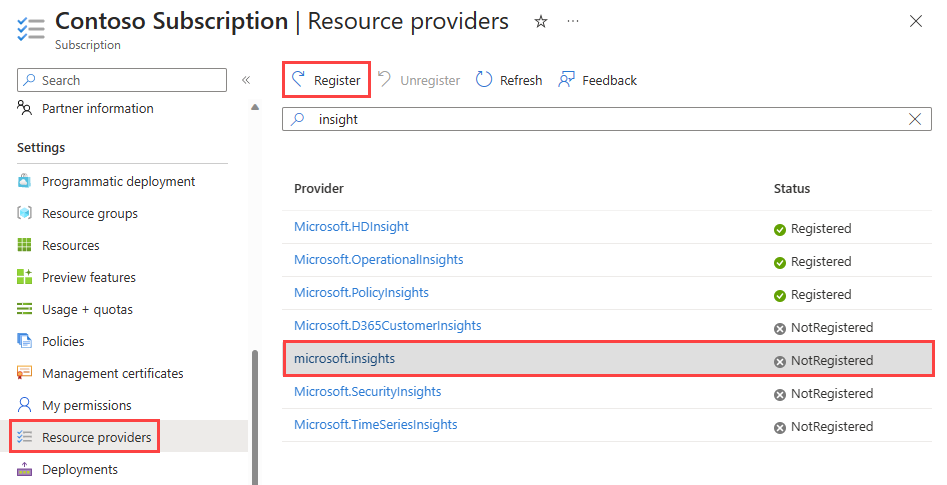
Create a flow log
Create a flow log for your virtual network, subnet, or network interface. This flow log is saved in an Azure storage account.
In the search box at the top of the portal, enter network watcher. Select Network Watcher from the search results.
Under Logs, select Flow logs.
In Network Watcher | Flow logs, select + Create or Create flow log blue button.
On the Basics tab of Create a flow log, enter or select the following values:
Setting Value Project details Subscription Select the Azure subscription of your virtual network that you want to log. Flow log type Select Virtual Network then select + Select target resource (available options are: Virtual network, Subnet, and Network interface).
Select the resources that you want to flow log, then select Confirm selection.Flow Log Name Enter a name for the flow log or leave the default name. Azure portal uses {ResourceName}-{ResourceGroupName}-flowlog as a default name for the flow log. Instance details Subscription Select the Azure subscription of the storage account. Storage Accounts Select the storage account that you want to save the flow logs to. If you want to create a new storage account, select Create a new storage account. Retention (days) Enter a retention time for the logs (this option is only available with Standard general-purpose v2 storage accounts). Enter 0 if you want to retain the flow logs data in the storage account forever (until you manually delete it from the storage account). For information about pricing, see Azure Storage pricing. Note
If the storage account is in a different subscription, the resource that you're logging (virtual network, subnet, or network interface) and the storage account must be associated with the same Microsoft Entra tenant. The account you use for each subscription must have the necessary permissions.
To enable traffic analytics, select Next: Analytics button, or select the Analytics tab. Enter or select the following values:
Setting Value Enable traffic analytics Select the checkbox to enable traffic analytics for your flow log. Traffic analytics processing interval Select the processing interval that you prefer, available options are: Every 1 hour and Every 10 mins. The default processing interval is every one hour. For more information, see Traffic analytics. Subscription Select the Azure subscription of your Log Analytics workspace. Log Analytics Workspace Select your Log Analytics workspace. By default, Azure portal creates DefaultWorkspace-{SubscriptionID}-{Region} Log Analytics workspace in defaultresourcegroup-{Region} resource group. 
Note
To create and select a Log Analytics workspace other than the default one, see Create a Log Analytics workspace
Select Review + create.
Review the settings, and then select Create.
Enable or disable traffic analytics
Enable traffic analytics for a flow log to analyze the flow log data. Traffic analytics provides insights into the traffic patterns of your virtual network. You can enable or disable traffic analytics for a flow log at any time.
To enable traffic analytics for a flow log, follow these steps:
In the search box at the top of the portal, enter network watcher. Select Network Watcher from the search results.
Under Logs, select Flow logs.
In Network Watcher | Flow logs, select the flow log that you want to enable traffic analytics for.
In Flow logs settings, check the Enable traffic analytics checkbox.
Enter or select the following values:
Setting Value Traffic analytics processing interval Select the processing interval that you prefer, available options are: Every 1 hour and Every 10 mins. The default processing interval is every one hour. For more information, see Traffic analytics. Subscription Select the Azure subscription of your Log Analytics workspace. Log Analytics Workspace Select your Log Analytics workspace. By default, Azure portal creates DefaultWorkspace-{SubscriptionID}-{Region} Log Analytics workspace in defaultresourcegroup-{Region} resource group. Select Save to apply the changes.
To disable traffic analytics for a flow log, take the previous steps 1-3, then uncheck the Enable traffic analytics checkbox and select Save.
Change a flow log
You can configure and change a flow log after you create it. For example, you can change the storage account or Log Analytics workspace.
In the search box at the top of the portal, enter network watcher. Select Network Watcher from the search results.
Under Logs, select Flow logs.
In Network Watcher | Flow logs, select the flow log that you want to change.
In Flow logs settings, you can change any of the following settings:
- Storage Account: Change the storage account that you want to save the flow logs to. If you want to create a new storage account, select Create a new storage account. You can also choose a storage account from a different subscription. If the storage account is in a different subscription, the resource that you're logging (virtual network, subnet, or network interface) and the storage account must be associated with the same Microsoft Entra tenant.
- Retention (days): Change the retention time in the storage account (this option is only available with Standard general-purpose v2 storage accounts). Enter 0 if you want to retain the flow logs data in the storage account forever (until you manually delete the data from the storage account).
- Traffic analytics: Enable or disable traffic analytics for your flow log. For more information, see Traffic analytics.
- Traffic analytics processing interval: Change the processing interval of traffic analytics (if traffic analytics is enabled). Available options are: one hour and 10 minutes. The default processing interval is every one hour. For more information, see Traffic analytics.
- Log Analytics Workspace: Change the Log Analytics workspace that you want to save the flow logs to (if traffic analytics is enabled). For more information, see Log Analytics workspace overview. You can also choose a Log Analytics Workspace from a different subscription.
Select Save to apply the changes.
List all flow logs
You can list all flow logs in a subscription or a group of subscriptions. You can also list all flow logs in a region.
In the search box at the top of the portal, enter network watcher. Select Network Watcher from the search results.
Under Logs, select Flow logs.
Select Subscription equals filter to choose one or more of your subscriptions. You can apply other filters like Location equals to list all the flow logs in a region.
View details of a flow log resource
You can view the details of a flow log in a subscription or a group of subscriptions. You can also list all flow logs in a region.
In the search box at the top of the portal, enter network watcher. Select Network Watcher from the search results.
Under Logs, select Flow logs.
In Network Watcher | Flow logs, select the flow log that you want to see.
In Flow logs settings, you can view the settings of the flow log resource.
Select Discard to close the settings page without making changes.
Download a flow log
You can download the flow logs data from the storage account that you saved the flow log to.
In the search box at the top of the portal, enter storage accounts. Select Storage accounts from the search results.
Select the storage account you used to store the logs.
Under Data storage, select Containers.
Select the insights-logs-flowlogflowevent container.
In insights-logs-flowlogflowevent, navigate the folder hierarchy until you get to the
PT1H.jsonfile that you want to download. Virtual network flow log files follow the following path:https://{storageAccountName}.blob.core.windows.net/insights-logs-flowlogflowevent/flowLogResourceID=/{subscriptionID}_NETWORKWATCHERRG/NETWORKWATCHER_{Region}_{ResourceName}-{ResourceGroupName}-FLOWLOGS/y={year}/m={month}/d={day}/h={hour}/m=00/macAddress={macAddress}/PT1H.jsonSelect the ellipsis ... to the right of the
PT1H.jsonfile, then select Download.
Note
As an alternative way to access and download flow logs from your storage account, you can use Azure Storage Explorer. For more information, see Get started with Storage Explorer.
For information about the structure of a flow log, see Log format of virtual network flow logs.
Disable a flow log
You can temporarily disable a virtual network flow log without deleting it. Disabling a flow log stops flow logging for the associated virtual network. However, the flow log resource remains with all its settings and associations. You can re-enable it at any time to resume flow logging for the configured virtual network.
In the search box at the top of the portal, enter network watcher. Select Network Watcher from the search results.
Under Logs, select Flow logs.
In Network Watcher | Flow logs, select the checkbox of the flow log that you want to disable.
Select Disable.
Note
If traffic analytics is enabled for a flow log, you must disable it before you can disable the flow log. To disable traffic analytics, see Enable or disable traffic analytics.
Enable a flow log
You can enable a virtual network flow log that you previously disabled to resume flow logging with the same settings you previously selected.
In the search box at the top of the portal, enter network watcher. Select Network Watcher from the search results.
Under Logs, select Flow logs.
In Network Watcher | Flow logs, select the checkbox of the flow log that you want to enable.
Select Enable.
Delete a flow log
You can permanently delete a virtual network flow log. Deleting a flow log deletes all its settings and associations. To begin flow logging again for the same virtual network, you must create a new flow log for it.
In the search box at the top of the portal, enter network watcher. Select Network Watcher from the search results.
Under Logs, select Flow logs.
In Network Watcher | Flow logs, select the checkbox of the flow log that you want to delete.
Select Delete.
Note
Deleting a flow log doesn't delete the flow log data from the storage account. Flow logs data stored in the storage account follows the configured retention policy or stays stored in the storage account until manually deleted.
Related content
- To learn about traffic analytics, see Traffic analytics.
- To learn how to use Azure built-in policies to audit or enable traffic analytics, see Manage traffic analytics using Azure Policy.
משוב
בקרוב: במהלך 2024, נפתור בעיות GitHub כמנגנון המשוב לתוכן ונחליף אותו במערכת משוב חדשה. לקבלת מידע נוסף, ראה: https://aka.ms/ContentUserFeedback.
שלח והצג משוב עבור
